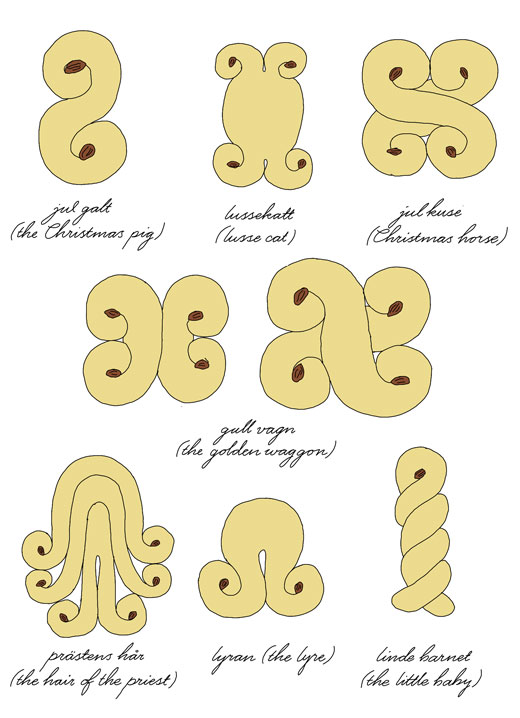
The 13th of December is the day when Swedes celebrate Saint Lucia by lighting up the darkness with candles and crowns on their heads. The Swedes also sing songs and eat funny shaped buns they call Lussebullar (Lussekatter, Saffron Buns). Even if Lucia’s day has already passed, anytime is ok to bake and enjoy these saffron rich buns. Below is Anna Brones’ recipe (updated and tweaked) from our book Fika. Please read Anna’s Lucia article over at Foodie Underground (with more illustrations by me).
Lussekatter – Saffron Buns
makes 30 to 40 buns
1/2 teaspoon saffron threads
dash of whiskey or cognac
3/4 cup (6 ounces, 170 grams) unsalted butter
2 cups (480 milliliters) milk
2 teaspoons active dry yeast
2 eggs
1/2 cup (3 ½ ounces, 100 grams) natural cane sugar
1 teaspoon salt
6 ½ cups (2 pounds, 925 grams) all-purpose flour
handful of raisins, for decoration
Using a spoon, crush the saffron in a small bowl. Then add a few drops of whiskey to help fully develop the saffron flavor and set aside.
In a saucepan, melt the butter; then stir in the milk. Heat until warm to the touch (about 110ºF/43°C). In a small bowl, dissolve the yeast in 2 to 3 tablespoons of the warm mixture. Stir and let sit for a few minutes until bubbles form on top of the yeast.
In a large bowl, whisk 1 of the eggs and blend in the sugar and salt and the saffron mixture. Pour in the remaining butter and milk and stir until well blended. Mix in the flour and work together with a wooden spoon or your hands until well combined.
Transfer the dough to the counter top or a flat surface and knead it until smooth and elastic, 3 to 5 minutes. The dough should feel a little wet, but if it sticks to your fingers and the counter top, add a little flour. Go lightly, though; if you add too much, the buns will end up dry. The dough is fully kneaded when you slice into it with a sharp knife and see small air bubbles throughout. Return the dough to the bowl, cover with a clean tea towel, and place in a draft-free place to rise until doubled in size, about 1 hour.
Grease a baking sheet. Remove the dough from the bowl and roll it into classic bun shapes (see diagram). Place the buns on the baking sheet with about 1 1/2 inches (4 centimeters) between each bun. Cover and let rise for 30 to 45 minutes.
While the dough is rising, preheat the oven to 400°F (200°C).
Whisk the remaining egg and brush on the tops of the buns. Decorate with currants (they traditionally go in the center of where the bun is rolled.)
Bake for 8 to 10 minutes. Remove from the oven and transfer the buns from the baking sheet to the counter. Cover with a tea towel and let cool before serving.
These buns dry out quickly, so if they are not eaten on the day you bake them, store them in the freezer.

Beautiful (like all your illustrations) and very helpful as well, thanks for sharing!
Thanks Foodfreak, I’m happy to hear that.
I made them last august and made the most delicious before flying to Europa sandwich..decadent with ham,mozz and tomatoes..it’s an acquired taste?
Jeremy: that sounds like a great sandwich. Can imagine that ham works really well with saffron. God jul!
This is really really cutie!!!
Thanks lapiubelladitutte!
Excellent drawing, Johanna – I usually just go for the “jul galt”, though I know there are many more shapes around. Linked to your drawing in my December post for saffron buns and next year try the other shapes as well 🙂
Greetings from Estonia!
Thanks Pille, I think the julgalt is the most common shape. Your Saffron Marzipan Buns with almonds looks really delicious!
Could I share your recipe for lussebullar with my readers? This is for our December issue but I would need to know by Tuesday of this week. Many thanks.
Cathy O’Kane
Vermontcountrysampler.com
Hi Cathy,
I have sent an answer to you by email.
best
Johanna
These! Oh my! I ate them at a Christmas market in Stockholm, a jul galt one by the looks of it!
Julgalt is the most common shape I think. Probably as its often smaller and easier to shape :). It’s for sure a wonderful classic.